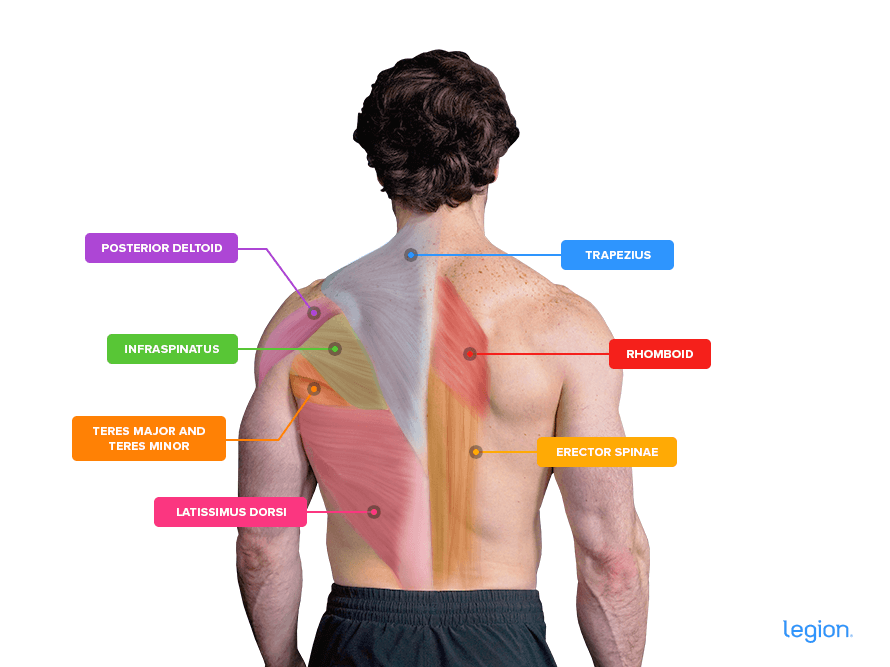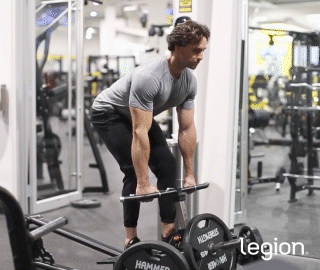The T-bar row is a staple in many weightlifters’ back workouts.
The reasons for this are numerous: it trains your entire back, allows you to lift heavy weights safely and progress regularly, and is highly adaptable, so you can change how you perform it to suit your preferences.
In this article, you’ll learn what the T-bar row is, its benefits, which muscles it works, how to perform it with proper form, the best T-bar row alternatives, and more.
What Is a T-Bar Row?
The T-bar row is a back exercise typically performed using a T-bar row machine.
While not all T-bar row machines are the same, most consist of a barbell anchored to the floor in a landmine attachment (also called a “T-bar row attachment”), a raised footplate, and a “T-bar row handle” (a handle that enables you to change the orientation and width of your grip).
To use the T-bar machine, you load the free end of the barbell with weight plates, straddle the bar with your feet on the footplate, bend over at the waist, and pull the barbell toward your torso.
T-Bar Row vs. Barbell Row
The main difference between the T-bar and barbell row is how you grip the barbell.
In the T-bar row, the T-bar row handle allows you to use a variety of grip widths. For example, you can take a narrow (hands 4-to-6 inches apart), medium (hands 6-to-18 inches apart), or wide (hands 18-to-24 inches apart) grip.
You can also orient your wrists in multiple ways: you can grip most handles with a pronated (palms facing down), supinated (palms facing up), or neutral (palms facing each other) grip, and some with a semi-pronated or semi-supinated grip.
Conversely, in the barbell row, you can only grip the barbell with a pronated or supinated grip. And while you can grip the barbell as wide as you like, the narrowest grip width you can comfortably use is shoulder-width or slightly narrower.
Some people exaggerate how these grip differences affect the exercises, suggesting how you position your hands greatly impacts which muscles you train.
This is mostly nonsense.
Changing your grip width and orientation likely changes which muscles you emphasize to a small degree, but it’s difficult to say whether this has a meaningful effect on long-term muscle growth.
In other words, both exercises train the same muscle to a comparable degree, and neither is better or worse than the other. And that’s why it doesn’t make sense to think in terms of barbell row vs. T-bar row and instead think in terms of barbell row and T-bar row.
A good way to include both exercises in your program is to do the T-bar row for 8-to-10 weeks of training, take a deload, then replace the T-bar row with the barbell row for the following 8-to-10 weeks of training.
Then, you can either continue alternating between the exercises every few months or stick with the one you prefer.
This is how I personally like to organize my training, and it’s similar to the method I advocate in my fitness books for men and women, Bigger Leaner Stronger and Thinner Leaner Stronger.
(And if you’d like even more specific advice about what exercises to include in your training program to reach your health and fitness goals, take the Legion Strength Training Quiz, and in less than a minute, you’ll know the perfect strength training program for you. Click here to check it out.)
T-Bar Row: Benefits
1. It trains your entire back.
Many people think that vertical pulling exercises develop your lats, which makes your back wider, and horizontal pulling exercises develop your traps, rhomboids, and teres muscles, which makes your back thicker.
This isn’t based on any sound scientific reasoning, though, and is essentially just gym lore. Research shows that horizontal pulling exercises, like the T-bar row, train your entire back, including your lats (perhaps even slightly better than vertical pulling exercises like the pull-up and lat pulldown).
Thus, all horizontal back exercises, including the T-bar row, make your back thicker, wider, and stronger.
2. It boosts your performance on other exercises.
Having a strong back is essential if you want to lift heavy weights—you can think of it as the scaffolding that supports the rest of your body.
It keeps your upper body tight and prevents you from tipping forward in the squat, stops your spine from rounding in the deadlift, and creates a stable base during the bench press.
The T-bar row allows you to lift heavy weights safely and progress regularly, which makes it ideal for gaining back strength that’ll boost your performance on other exercises.
3. It’s highly adaptable.
A T-bar row handle allows you to vary your grip width and orientation while you perform the exercise.
The most common variation (and the one we’ll focus on in this article) is the neutral-grip T-bar row, which places your hands about 6-to-18 inches apart with your palms facing each other.
Other popular variations include the . . .
- Wide-grip T-bar row, which involves a pronated (palms facing toward your body) grip just outside shoulder-width apart
- Close-grip T-bar row, which places your hands about 4-to-6 inches apart with your palms facing each other
Periodically changing your grip is useful because it keeps your workouts interesting and helps you avoid shoulder and elbow overuse injuries, which can occur when you do the same pulling exercise for an extended period.
T-Bar Row: Muscles Worked
The main muscles worked by the T-bar row are the . . .
- Latissimus dorsi
- Trapezius
- Rhomboids
- Teres major and minor
- Posterior deltoids
- Infraspinatus
- Erector spinae
It also trains your biceps, forearms, and core to a lesser degree, too.
Here’s how the main muscles worked by the T-bar row look on your body:

How to Do the T-Bar Row
The best way to learn how to do the T-bar row is to split the exercise into three parts: set up, row, and extend.
1. Set up
Load the T-bar row machine with weights and stand on the footplate so that the barbell is between your legs and you’re facing the weighted end of the barbell.
While keeping your back flat, bend your knees slightly and “hinge” forward at the hips until your upper body is at a 30-to-45-degree angle relative to the floor. Grab the T-bar row handle with a neutral grip and your hands 6-to-18 inches apart and lift the bar off the rest so that you’re supporting the weight.
2. Row
While keeping your back flat, pull the handle toward your abdomen. Continue pulling until the handle touches your torso and your elbows are about 4-to-6 inches from your sides.
(Tip: A helpful cue is to imagine touching the ceiling with your elbows.)
3. Extend
Once the T-bar row handle touches your torso, reverse the movement and return to the starting position. This is a mirror image of what you did during the row.
Don’t let the weight yank your arms back to the starting position or try to extend your arms slowly. The entire “extension” should be controlled but only take about a second.
Here’s how it should look when you put it all together:

The Best T-Bar Row Alternatives
1. Chest-Supported T-Bar Row
In the chest-supported T-bar row, the chestpad prevents you from using momentum to “cheat” the weight up, which forces your back muscles to do the majority of the work. Resting on a chestpad also means you don’t support the weight with your spine, making the chest-supported T-bar row an excellent T-bar row alternative for people training around a lower-back injury.
2. Cable Row
The main benefit of the cable row (sometimes referred to as the “seated T-bar row” or “cable T-bar row”) is that by using a cable, there’s constant tension on your back muscles throughout each rep. This taxes your back slightly differently from the regular T-bar row.
3. Barbell Corner Row
The only difference between the barbell corner row and T-bar row is that in the barbell corner row, you trap one end of a barbell in the corner of a room or squat rack instead of anchoring it in a T-bar row attachment. This makes the barbell corner row an excellent way to perform the T-bar row with a barbell when you don’t have access to a T-bar row machine (when training in a home gym, for example)
4. Single-Arm Landmine T-Bar Row
The single-arm landmine T-bar row (or “one-arm T-bar row”) places the weight behind your body. This changes the bar’s path as you lift the weight, which may emphasize your mid-back muscles (lats and mid traps) slightly more than your upper-back muscles (upper traps and rhomboids).
5. One-Arm Dumbbell Row
The one-arm dumbbell row is basically a T-bar row with dumbbells. This makes it an excellent variation for people who want to do the T-bar row at home, but have limited equipment and space.
Scientific References +
- Hajilou, B., Anbarian, M., & Golparian, M. (2017). The comparison of the electromyography activities in the latissimus dorsi and trapezius muscles during two types of strength training. Journal of Practical Studies of Biosciences in Sport, 5(9), 43–51. https://doi.org/10.22077/JPSBS.2017.620
- Youdas, J. W., Keith, J. M., Nonn, D. E., Squires, A. C., & Hollman, J. H. (2016). Activation of spinal stabilizers and shoulder complex muscles during an inverted row using a portable pull-up device and body weight resistance. Journal of Strength and Conditioning Research, 30(7), 1933–1941. https://doi.org/10.1519/JSC.0000000000001210
- Lehman, G. J., Buchan, D. D., Lundy, A., Myers, N., & Nalborczyk, A. (2004). Variations in muscle activation levels during traditional latissimus dorsi weight training exercises: An experimental study. Dynamic Medicine : DM, 3, 4. https://doi.org/10.1186/1476-5918-3-4










